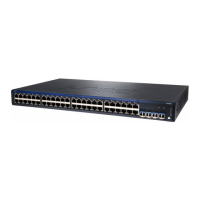Configuring Local Link Bias (CLI Procedure)
Local link bias is used to conserve bandwidth on Virtual Chassis ports (VCPs) by using
local links to forward unicast traffic exiting a Virtual Chassis or Virtual Chassis Fabric
(VCF) that has a Link Aggregation group (LAG) bundle composed of member links on
different member switches in the same Virtual Chassis or VCF. A local link is a member
link in the LAG bundle that is on the member switch that received the traffic. Because
traffic is received and forwarded on the same member switch when local link bias is
enabled, no VCP bandwidth is consumed by traffic traversing the VCPs to exit the Virtual
Chassis or VCF on a different member link in the LAG bundle.
You should enable local link bias if you want to conserve VCP bandwidth by always
forwarding egress unicast traffic on a LAG out of a local link. You should not enable local
link bias if you want egress traffic load-balanced as it exits the Virtual Chassis or VCF.
To enable local link bias on a LAG bundle:
[edit]
user@switch# set interface aex aggregated-ether-options local-bias
where aex is the name of the aggregated Ethernet link bundle.
For instance, to enable local link bias on aggregated Ethernet interface ae0:
[edit]
user@switch# set interface ae0 aggregated-ether-options local-bias
Related
Documentation
Understanding Local Link Bias on page 16•
Configuring the Fields in the Algorithm Used To Hash LAG Bundle and ECMP Traffic
(CLI Procedure)
Juniper Networks EX Series and QFX Series switches use a hashing algorithm to determine
how to forward traffic over a Link Aggregation group (LAG) bundle or to the next-hop
device when equal-cost multipath (ECMP) is enabled.
The hashing algorithm makes hashing decisions based on values in various packet fields,
as well as on some internal values like source port ID and source device ID. You can
configure some of the fields that are used by the hashing algorithm.
Configuring the fields used by the hashing algorithm is useful in scenarios where most
of the traffic entering the bundle is similar and the traffic needs to be managed in the
LAG bundle. For instance, if the only difference in the IP packets for all incoming traffic
is the source and destination IP address, you can tune the hashing algorithm to make
Copyright © 2015, Juniper Networks, Inc.94
Network Interfaces for EX4300 Switches

